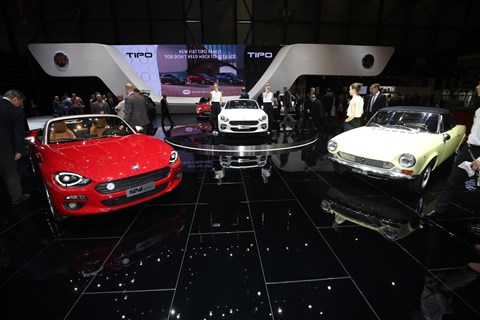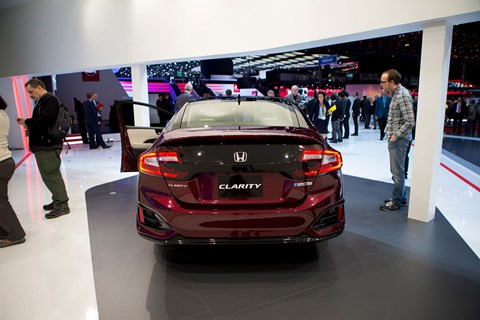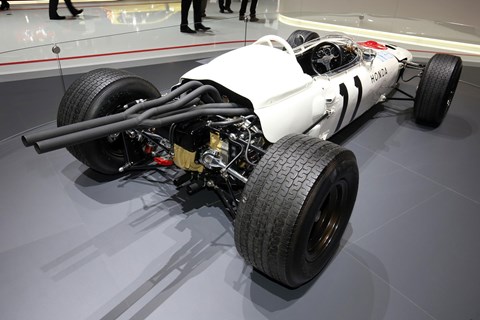► The hits and misses of the Geneva motor show
► An analysis by seasoned show-goer Gavin Green
► Do you agree? Sound off in the comments below!
So what were the major auto industry trends at the 2016 Geneva motor show? Silly question. That’s like asking what Vanity Fair’s Oscars party tells us about the state of amateur dramatics.
Geneva is more glamorous catwalk than a barometer of tomorrow’s real world cars. Of course inside the sweaty interview rooms, in the bowels of the show stands, CEOs and engineering directors were pontificating on zero emissions and self-driving cars and clever new interpretations on personal mobility.
And out on the catwalk, there was some evidence of all three trends, especially zero-emission cars. (My favourite was the electric DS E-Tense, though what a shame that the first part of its name is a corruption of a great badge, and the second a corruption of our great language.)
Instead, big power, wild style and outrageous speed dominated the plinths, just as it usually does at Geneva. Journalists were frequently summoned to press conferences by six- eight- or 12-cylinder bellow, car worshippers called to petrol-power prayer.
The star cars of the Geneva motor show
There was the bonkers new 200mph Jaguar F-Type (the SVR), for those who find the F-Type R just a bit too much of a pussy. There was the mega-bonkers Lamborghini Centenario, a limited edition 760bhp V12 dream machine, commemorating the birth 100 years ago of company founder Ferruccio, and a neat excuse to liberate £1.6 million from the Swiss bank accounts of 40 super wealthy buyers.
Then there was the maxi-bonkers £1.9 million Bugatti Chiron, for those oligarchs, sheiks and dot com billionaires who like the feel of almost 1500bhp under toe, and the fantasy of a 260mph top speed.
Nearer the sports car real world, there was a delectable new Porsche 718 Boxster (though now sadly denied six-cylinder power), another new 911 iteration (the R) that may just be the best rear-engine Porsche yet (think GT3 RS without the crazy wing and with life-enhancing proper manual gearshift) and an impressive new car from McLaren (the 570GT) that has a hatchback rear, although the comparisons with a Golf end there.
The new Fiat 124 Spider (below) looks inviting, though it’s a sign of the mainstream Fiat brand’s dynamic demise that they need to turn to invigorated Mazda for sports car know-how and hardware. Even more embarrassing for an Italian company, the Mazda version looks better.

The supercars of Geneva
My favourite supercar on show was the Aston Martin DB11. It looks gorgeous, a superb example of beautifully proportioned sculpture, and thus no need for the styling froth that blights many modern cars. There were some brilliant engineering touches too, none more than the ingenious rear ‘Aero Blade’ that achieves the downforce of a large rear wing without any appendage hanging above or behind.
There was a plethora of new SUVs, like any modern car show, but quite the best new crossover/multi-activity vehicle I saw was the Renault Scenic, more people mover than SUV-like armoured personnel carrier, a beguiling mix of French design flair and functionality. This is the sort of car the French historically do best, although sadly Renault hasn’t done one for rather a long time.
My other real-world favourites were the elegant Volvo V90 estate and the fine new Mercedes E-class, a real step-ahead Benz, especially in its cabin architecture.
The rogues of Geneva
There were some styling horrors, of course. There were the usual tarted-up monsters offered by certain tuning houses – gilded Rollers, Bentleys-with-baubles, butch BMWs, rogue Rangies and modified Mercs, mostly.
Then, there were two particularly misguided mainstream examples of frilly over-ornamentation, in which design details have been ladled on, presumably because the stylists haven’t found a pleasing basic form and must defer to visual chaos to grab attention. Both came from Honda, once Japan’s design exemplar.
I refer to the prototype of the new Civic hatch, on sale in 2017, and, even worse, the new Honda Clarity (below), first shown at last year’s Tokyo show. Both betray Honda’s lack of design confidence and direction.

The Clarity’s technology is, of course, far-sighted and brilliant. Its style is frenzied and bizarre. It’s a tangle of disjointed creases, folds, bulges, edges, slants and angles. Someone please tell Honda that simple elegant forms are best! For evidence, look at the 1965 Formula 1 Honda, on display just a hundred metres away (below), a delectable cigar-shaped projectile of fabulous form-follows-function simplicity and loveliness. Or study the style of Mazda’s RX Vision on the adjacent stand, a minimalist sliver of slippery and seductive sculpture.
Get the basic shape right, and frilly embellishment is quite unnecessary. A work of technical genius, such as the Clarity, deserves much better.
Do you agree with Gavin? Be sure to comment below and share your hits and misses of the show
Read more of CAR’s 2016 Geneva motor show coverage here
Click here for CAR’s A-Z guide to the 2016 Geneva motor show
